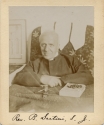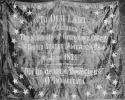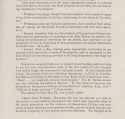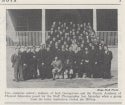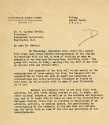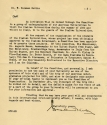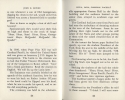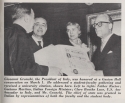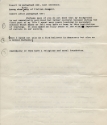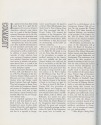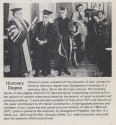The 2016 John Carroll Weekend will be held in Rome, Italy, from April 14-17. In celebration of this occasion, the Archives presents this online exhibit highlighting some historic connections between Georgetown and Italy. These connections date back at least to October 26, 1810, when Giovanni Grassi, S.J., arrived at Georgetown and became vice-president. Several Italian Jesuits, including Father Grassi, who made unique contributions to the character and development of Georgetown College in the 19th century are featured, as are student and alumni visits to Italy, and visits to campus by Italian political, religious and cultural figures.
Giovanni or John Grassi, S.J., President of Georgetown from 1812 to 1817. Photograph of a portrait from the University Art Collection
Giovanni Grassi, S.J., was born in Bergamo, Italy, in 1775 and entered the Society of Jesus in Russia in 1799. He arrived in the U.S. in 1810 and was sent to Georgetown. The Jesuit Superior General in Russia named him as Georgetown's ninth President in October 1811, although the letter communicating this decision was delayed by the Napoleonic Wars in Europe and did not reach the College until the following year.
Although Father Grassi's name is largely unknown on campus today, he successfully guided Georgetown College back from the brink of closure due to low enrollment (only 31 students were at the College when he became President) and insufficient revenues. By the time he returned to Rome in 1817, Georgetown was a re-invigorated school with 107 students, a federal charter which enabled it to award degrees for the first time, a growing library of more than 5,000 volumes, and a group of able faculty. He died in Rome on December 12, 1849.
Letter from J[ohn] Grassi, S.J., to John McElroy, S.J., about the arrival of the six Americans scholastics in Naples, 8/27/1820 (Maryland Province Archives)
Joseph Finotti, S.J.
Joseph Maria Finotti, S.J., was born in Ferrara in Northern Italy in 1817, the year that Fr. Grassi left America. He worked at Georgetown on and off between 1845 and 1849, as a professor and assistant librarian, then as librarian. As assistant librarian, he compiled the first detailed statistical survey of the College Library. He later planned to create a subject catalogue of the collection. This work was not completed by the time he left Georgetown for good in 1849; however, he left extensive notes. Our knowledge of the College Library in the 1840s derives largely from his work.
Fr. Finotti left the Jesuit Order in 1852 and moved to Massachusetts, where he served as a parish priest and literary editor of the Boston Pilot. In 1872, he published his Bibliographica Catholica Americana, the first serious attempt to create a list of books by Catholic authors published in America from 1820.
Angelo Secchi, S.J.
The Georgetown College Observatory, one of the first fixed astronomical observatories in the U.S., was constructed in the early 1840s. Astronomical studies on campus received a stimulus with the arrival of Fathers Angelo Secchi and Benedict Sestini who, with a number of other Italian Jesuits, came to Georgetown after the revolutions of 1848 in Italy.
Fr. Secchi is often referred to as the father of astrophysics. He made the first survey of the spectra of stars and suggested that stars be classified according to their spectral type. Georgetown's rare book collections include extensive holdings of Fr Secchi's scientific publications.
Born in Reggio Emilia in northern Italy in 1818, Fr. Secchi entered the Jesuit Order at the age of fifteen. He arrived at Georgetown on November 22, 1848, and left in the fall of 1849 to return to Rome. He was 31 years old when he arrived and did not speak fluent English, which limited his ability to teach, but he did assist the professor of physics and a room in the Infirmary [Gervase] was given to him to conduct experiments. Accounts in the archives tell us, for example, that he constructed an electric battery which he used in a public demonstration at 1849 commencement to lift a weight of 1600 pounds.
On his return to Italy, he became director of the Observatory at the Roman College. In 1870, with the capture of Rome—the final event in the unification of Italy under Victor Emmanual II—the Observatory came under the control of the Italian Government. Out of respect for his reputation and scientific achievements, however, Father Secchi was allowed to continue his work there until his death in 1878.
Benedict Sestini, S.J. Pictured ca. 1890
Father Sestini was born in Ferrara, Italy, in 1816. Trained principally as an astronomer and mathematician, he was made assistant director of the fledgling Georgetown College Observatory and taught mathematics at Georgetown College, Woodstock College in Maryland (which he helped plan), and Boston College. In 1866, he issued the first number of an American edition of The Messenger of the Sacred Heart, the principal organ of the Apostleship of Prayer, and for the next 20 years he was the sole editor of the American edition. Unlike Fr. Secchi, he did not return to Italy and died at Frederick, Maryland in 1890.
Sunspot drawing made at Georgetown by Benedict Sestini, S.J, September 19, 1850
In 1850, Fr. Sestini conducted a series of observations of sunspots. First published in 1853, these were immediately recognized as an authoritative study of the subject. The book into which his original drawings are bound notes that the drawings were taken by Father Sestini from the South Door of the Infirmary [Gervase] and drawn by hand from successive views of the sunspots from the telescope used September and October etc. 1850
Fr. Sestini also published a series of texts on different branches of mathematical studies. These were used in the curriculum at Georgetown and at many other institutions including West Point.
Record of the enrollment of Lorenzo Massone of Naples, Italy, on September 6, 1859. From the Record of the Alumni of Georgetown College, 1812-1879
Lorenzo is the earliest Italian student that archives staff have been able to identify. He was the son of Pascal Massone, the Neapolitan Minister. Chevalier Massone was recalled by the King of Naples in September 1860 and his son appears to have left Georgetown at this time.
John B. Guida, S.J.
Born in Italy, Fr. Guida taught philosophy at Georgetown from 1863 to 1868. He had the misfortune to bear a physical resemblance to John Wilkes Booth and, as a result, to be arrested in the aftermath of President Lincoln’s assassination. According to one account of the incident, he was arrested near Georgetown and taken to a military camp in Virginia where he was held, unable to prove his identity, until the real John Wilkes Booth was located.
Flag presented to Lourdes by Georgetown students in June 1874 after it had been blessed by the Pope in Rome
Two Georgetown students, Frank and Eugene Ives, made a pilgrimage to Lourdes, France, and Rome, Italy, in 1874. They took with them an United States flag, eight feet by five feet. The flag, after it had been blessed by the Pope, was presented to the Church of Notre Dame de Lourdes. It hung in the church's sanctuary for many years and was later returned to the University.
Resolutions passed at a meeting of Georgetown College students on April 24, 1874, regarding the flag and the pilgrimage to Rome and Lourdes. From Memorial of the First Century of Georgetown College, 1891, by John Gilmary Shea, page 251
Gaston Hall decorated for an event in honor of first Apostolic Delegate to the U.S., Francesco Cardinal Satolli, April 31, 1896
Cardinal Satolli was born in 1839 at Marsciano near Perugia in Central Italy. Over one thousand people were invited to a program of speeches and music in Healy Hall held in honor of his departure from the U.S. after a stay of three years. Georgetown President J. Havens Richards, S.J., began his address with these words: The farewell which the faculty, the students, and the friends of Georgetown have gathered to-day to bid you, is spoken in sadness. During the three years and more that you have spent with us, you have gained a large place in our hearts and a strong hold upon our affections. To the authority in which you came clothed as the representative of the person and authority of our Holy Father, Leo XIII, and which commanded our reverence, were speedily added the regard due to your exceptional abilities and attainments, the respect compelled by your firm and impartial administration of the duties of your high office, and the affection engendered by your gentle and fatherly kindness, and the fascination of your personal manner. To be obliged to say goodbye when we have just learned to know and love you fully, cannot but be a cause of regret and disappointment.
Giacomo de Martino, the Envoy of Italy to the United States. Pictured in an unidentified publication, ca. 1929
As part of the observance of the golden jubilee of the priesthood of Pope Pius XI, an honorary degree was bestowed on Giacomo de Martino, the Envoy of Italy to the United States in December 1929.
Portion of the speech by Giacomo de Martino, the Envoy of Italy to the United States, on the occasion of the award of an honorary degree by Georgetown University in 1929. From an unidentified publication
Arturo Toscanini, conductor of the New York Philharmonic Orchestra (right), at Founders’ Day, March 25, 1930
Toscanini, who was born in Parma, Italy, and Paul Claudel, French Ambassador to the U.S. (left), received academic medals at Founders' Day exercises on campus, March 25, 1930. University President W. Coleman Nevils, S.J, (center) made the presentations.
The first Founders’ Day celebration was held in January 1908 and was linked to the anniversary of the birth of Georgetown founder, John Carroll. This event ceased in 1914. In 1930, the concept of Founders’ Day was revived by Father Nevils. It was celebrated on March 25, the date of the landing of the ships (the Ark and the Dove) which brought the first colonists, including three Jesuits—Andrew White, John Altham (Gravenor) and Thomas Gervase—to Maryland. Founders’ Day was celebrated on campus until 1968.
Account of a visit by Italian student athletes to Georgetown, The Hoya, March 4, 1931
The group of athletes were on a six-month tour of the United States.
Letter from Gustavus T. Kirby to Georgetown President W. Coleman Nevils, S.J., re a visit by around 350 Italian students, August 10, 1934, and reply by President Nevils, August 14, 1934
Mr. Kirby was chair of the committee that organized the visit. The students, who spent three weeks in the United States, were welcomed to Washington, D.C., by Secretary of State Cordell Hull; Bishop James H. Ryan, President of Catholic University, who spoke to them in Italian; and Edmund A. Walsh, S.J., Vice President of Georgetown, who addressed them in Latin.
Eugenio Cardinal Pacelli receives an honorary degree from Georgetown University, October 22, 1936. Pictured from left to right: Edmund A. Walsh, S.J.; Archbishop Amleto Cicognani, the Apostolic Delegate; Cardinal Pacelli; and Arthur A. O'Leary, S.J.
In 1936, Eugenio Cardinal Giovanni, who was born in Rome in 1876, visited the U.S. and was given an honorary degree by Georgetown. At the time of the visit, he was Cardinal Secretary of State, responsible for foreign policy and state relations throughout the world. After the death of Pope Pius XI in 1939, Cardinal Pacelli was elected Pope, selecting the name Pius XII.
Account of honorary degree ceremony for Eugenio Cardinal Pacelli, October 22, 1936, by John G. Bowen (LL.B. 1921, LL.M. 1922, Ph.D. 1933). In On the Hilltop: Reflections and Reminiscences on their Campus Years by Georgetown Alumni, 1966
The ceremony took place in Gaston Hall, with the audience limited to the senior class. As Bowen explains, after the degree had been conferred, the class honored the Cardinal with a variation of the College cheer which was normally delivered at sporting events as: Hoya, Hoya, Saxa! Hoya, Hoya, Georgetown! -Team, Team, Team!
"A Roamin' Holiday" by Don Libert, F 1950. Description of the Georgetown Pilgrimage to Italy and other parts of Europe in the Georgetown University Alumni Magazine, summer 1950
Our Lady of Fatima statue, carved in Italy. Photograph by Lawrence R. McHugh, S.J., June 9, 1950
The Class of 1950 presented the University with a statue of Our Lady of Fatima as their class gift. The Class felt that a statue of Our Lady should have a prominent location on campus to increase devotion and so that May devotions could be held in a suitable place. Made of Carrara marble in Italy, the original statue was broken as it was loaded on board ship for its journey to the U.S., so a second identical statue had to be made. The second statue arrived on campus in time to be dedicated at the 1950 commencement exercises. The statue is situated facing Copley Hall and its base is inscribed with the words: Our Lady of Fatima, P A X, Class of 1950. The Senior Gift Committee estimated that $2000 would be needed to pay for the statue. Over $3000 was raised and the Committee was also able to buy trees to plant behind the statue.
Coverage of the visit of the President of Italy Giovanni Gronchi, March 1, 1956. In Georgetown Record, March 1956
Italian Premier Antonio Segni and Foreign Minister Giuseppe Pella receiving honorary degrees, October 1, 1959. In Georgetown Record, November 1959
Georgetown President Edward B. Bunn, S.J., said in his introduction that the two were friends, equal partners and allies in the common striving and yearning of all of us for freedom, and honor and human dignity.
Georgetown University Alumni Magazine, spring 1967. Reference to the formation of an Alumni Club in Rome, Italy, as well as in Paris, France and in London, England
Simcha Dinitz, F 1953. Pictured in the Protocol [Foreign Service School yearbook], 1953
Simcha Dinitz was born in Tel Aviv in 1929. After graduating from Georgetown, he joined the Israeli Ministry of Foreign Affairs and served in a number of positions over the next thirty years, including as Minister at the Israeli Embassy in Rome, Italy, from 1966-1968 and Israeli Ambassador to the United States from 1973-1978. He served as chair of the admissions committee of Alumni Club in Rome when the Club was established in 1967.
Giovanni Leone, President of Italy, receiving an honorary degree from Georgetown University President Robert J. Henle, S.J. In Georgetown Today, November 1974
Georgetown Magazine cover, March/April-May/June 1980 issue, with a photograph of Villa le Balze
In 1980, Villa le Balze, a 26 room villa, and three acres of land in Fiesole, Italy, overlooking the Arno Valley, were donated to Georgetown by Marquesa Margaret Rockefeller de Larrain, the only surviving granddaughter of John D. Rockefeller. The donation was made in memory of her father, educator Charles A. Strong, who built the villa in 1920 and lived in it until his death in 1940. The villa had been unoccupied since his death, except for a period during World War II when it was occupied by the German military.
The Villa now provides students with the opportunity to study abroad for a semester, year or summer and also hosts conferences and lectures that are open to the local community in Fiesole and Florence.
"Gift worth $1.8 million – Georgetown University to use Italian Villa for Study Abroad Programs." Georgetown News release, January 25, 1980
Program from an address on “The Current State of European-American Relations” by the Minister of Foreign Affairs of Italy Emilio Colombo, February 18, 1982
The address, which was arranged in cooperation with the Embassy of Italy, the Institute for the Study of Diplomacy, and the World Affairs Council of Washington, D.C., was held in Gaston Hall. The Georgetown Voice reported in its March 2, 1982, issue that the address was extremely informative and covered different facets of the current international situation. Colombo spoke in Italian and therefore the non-Italian speaking audience was given a translation of the lecture. Towards the end of his address Colombo proposed a formal “Euro-American Friendship Pact strengthening democracy and cooperation which should, naturally, cover the political aspects of East-West relations . . . “
Honorary degree citation in English and in Italian for the Prime Minister of Italy, Giovanni Goria, December 17, 1987
In July 1987, Christian Democrat Giovanni Goria formed Italy’s 47th post-World War II government and, at the age of 44, became Italy’s youngest Prime Minister. He visited Washington in December 1987, accompanied by Foreign Minister Giulio Andreotti.
Curated by Lynn Conway, University Archivist

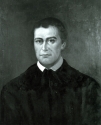
![Letter from J[ohn] Grassi, S.J., to John McElroy, S.J., front side](/sites/default/files/2_Grassi%20to%20McElroy%20August%201827_MPA%2059_6_thumb.jpg)
![Letter from J[ohn] Grassi, S.J., to John McElroy, S.J., back side](/sites/default/files/2_Grassi%20to%20McElroy%20August%201827_MPA%2059_6-back_2_thumb.jpg)


